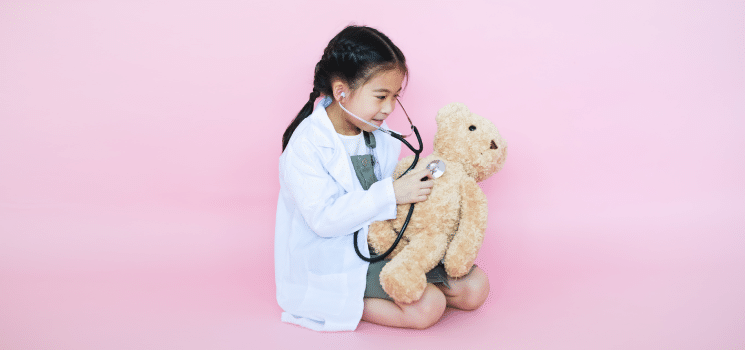The following article was written by Amy Greenburg and published by Expat Living Singapore on 15th June 2021 (link).
Why see a paediatrician if your child’s not sick? From checking to see if your baby is meeting developmental milestones to detecting unnoticed health conditions, regular wellness checks are important. Here,
DR SHERMELA APPAN, paediatrician at StarMed Specialist Centre, shares how well checks for babies and kids may help in the long term, and how often your child should go for a well-child visit.
Should my child see a paediatrician for wellness checks?
Even if your child isn’t sick, routine visits to the paediatrician are key to tracking their development and knowing whether or not they’re meeting developmental milestones. In fact, the value of assessing a child’s development and growth in the first few years of life can’t be emphasised enough. The same goes for regular annual checks in older children up to adolescence.
Regular wellness checks are crucial in picking up any signs of underlying problems. They’re also an opportunity to discuss preventative health measures and any parental concerns; this can include feeding, sleep problems, behavioural issues and more.
Schedule an appointment with our resident paediatrician, Dr Shermela Appan, here for a wellness check for your child.
How often should my child see a paediatrician for wellness checks?
Well checks for babies start soon after the first newborn examination in the nursery. Visits to the paediatrician are scheduled between three to five days after birth. This is followed visits at one, two, four, six, nine, 12, 18, 24 and 30 months.
During the initial well checks for babies, the paediatrician will likely focus on feeding and sleep patterns, and the baby’s social and behavioural responses. Your baby’s growth is monitored so that problems with poor or excessive weight gain can be addressed and managed as early as possible. Apart from the physical examination, the paediatrician will check on the baby’s cognition, communication, behaviour, social interaction, motor and sensory abilities. This helps ensure that age-appropriate developmental milestones are being met.
From the age of three, a well child visit to the paediatrician is usually scheduled yearly. However, some parents tend to slip up on yearly assessments after the second year on completion of vaccinations. In doing so, they run the risk of delayed diagnosis of certain conditions, which may present later in childhood.
What does a paediatrician in Singapore normally check for in a well-child visit?
Apart from assessing whether your child is meeting the appropriate developmental milestones, a simple visit to the paediatrician could mean identifying certain conditions you may have otherwise missed at the right time. In fact, some conditions don’t present with any symptoms until later in childhood. So, during a wellness check or annual examination, your paediatrician may look for:
Congenital heart defects
While most congenital heart defects are detected before birth during ultrasounds or soon after birth, some children aren’t diagnosed until they’re older with consequent complications.
Eye problems
Eye problems can be easily overlooked by many parents, particularly with young children. Squints may sometime present with a compensatory head tilt or face turn. As a paediatrician in Singapore, I once encountered a three-year-old patient whose squint was masked by her head tilt. Her parents assumed it was just a habit and ignored it. However, the problem was picked up incidentally when she was seen for another health complaint subsequently. The earlier the diagnosis, the better the outcome for the child. Late diagnosis can lead to a lazy eye, which can affect visual development and, consequently, result in partial or total blindness. Therefore, early detection and a referral to the paediatric ophthalmologist is key to a good prognosis.
Walking abnormalities
In-toeing or out-toeing gaits are common gait abnormalities seen in toddlers. While they may self-correct as children grow up, a follow-up is advisable, as the problem can persist. Some kids may require further assessment.
Hearing problems
Hearing problems, too, can easily go unnoticed during childhood. For example, I had a patient who experienced moderate hearing loss in mid-childhood that went undiagnosed until she was in Primary 1. Although her newborn hearing test was normal and her speech development wasn’t delayed, her hearing test at age seven revealed hearing loss in both ears. Her parents had noticed that she didn’t socialise much and spoke very little; yet they simply attributed this to shyness with strangers. It wasn’t until she had trouble academically that she was checked. Luckily, this problem was easily corrected with the use of hearing aids, and her academic performance and social interaction has since improved.
Obesity
Mistakenly, some parents overlook excessive weight gain under the assumption that it’s acceptable for kids to be overweight and that the problem will resolve as they get older. However, research has shown that obese children and adolescents are five times more likely to be obese in adulthood. Obese children have a higher risk of developing Type 2 Diabetes Mellitus, high blood pressure, high cholesterol, obstructive sleep apnoea (OSA) and joint problems. They’re also more prone to bullying, and its attendant psychological issues. For these reasons, it’s a good idea to stay up to date with wellness checks with your paediatrician in Singapore.
Scoliosis
Scoliosis (curved spine) occurs most often between the ages of 10 to 15 years old in both boys and girls. This is the period of active pubertal growth spurt. Mild curves will often initially go unnoticed because they do not usually cause pain. Luckily, paediatricians can detect these types of abnormalities that parents would have otherwise missed.
Dr Shermela Appan has been a Singapore Ministry of Health-accredited paediatrician for 39 years, with special interests in child development, puberty, asthma and allergies. She also has 29 years of private paediatric experience as a partner at The Children’s Medical Centre in Bishan, prior to joining StarMed Specialist Centre. Hear what she has to say about her work and some memorable experiences here.






